Evaluating Nokia's Digital Marketing Strategy & Competitor Analysis
VerifiedAdded on 2023/06/13
|7
|1164
|298
Report
AI Summary
This report analyzes Nokia Corporation's digital marketing strategies, highlighting the factors that led to its decline in market share despite an initial strong position. It evaluates Nokia's failure to adapt to the shift towards touchscreen smartphones and application-based systems, its ineffective value proposition, and its lack of engagement on social media platforms. The report contrasts Nokia's approach with the successful digital marketing strategies of Apple, which include consistent blogging, active social media engagement, and effective use of visual content on platforms like Instagram. Ultimately, the report recommends that Nokia should have focused on building an online community, understanding consumer needs, and adopting a transparent approach to improve its digital marketing standards. Desklib offers a wealth of similar reports and solved assignments for students seeking to deepen their understanding of marketing strategies.

REPORT
Paraphrase This Document
Need a fresh take? Get an instant paraphrase of this document with our AI Paraphraser
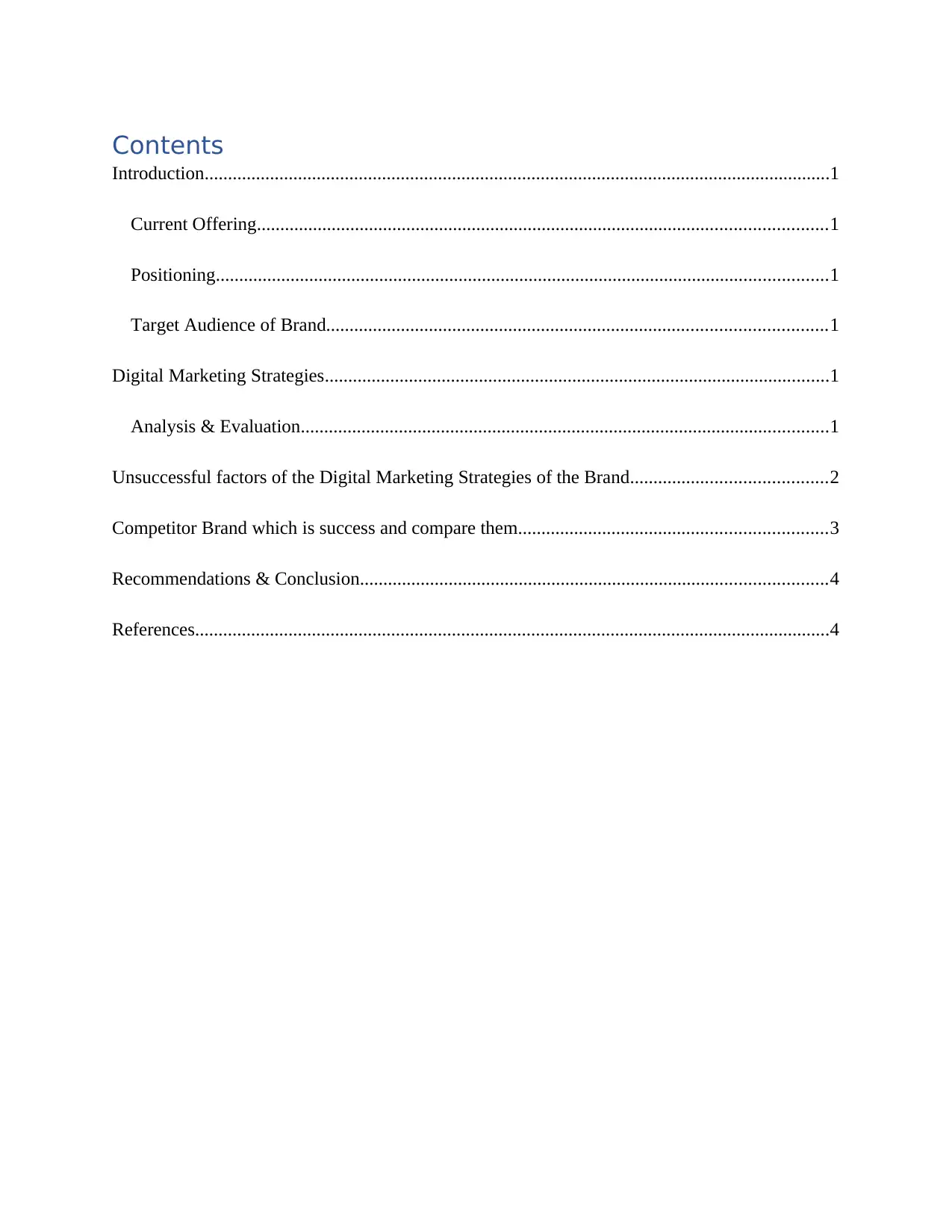
Contents
Introduction......................................................................................................................................1
Current Offering..........................................................................................................................1
Positioning...................................................................................................................................1
Target Audience of Brand...........................................................................................................1
Digital Marketing Strategies............................................................................................................1
Analysis & Evaluation.................................................................................................................1
Unsuccessful factors of the Digital Marketing Strategies of the Brand..........................................2
Competitor Brand which is success and compare them..................................................................3
Recommendations & Conclusion....................................................................................................4
References........................................................................................................................................4
Introduction......................................................................................................................................1
Current Offering..........................................................................................................................1
Positioning...................................................................................................................................1
Target Audience of Brand...........................................................................................................1
Digital Marketing Strategies............................................................................................................1
Analysis & Evaluation.................................................................................................................1
Unsuccessful factors of the Digital Marketing Strategies of the Brand..........................................2
Competitor Brand which is success and compare them..................................................................3
Recommendations & Conclusion....................................................................................................4
References........................................................................................................................................4
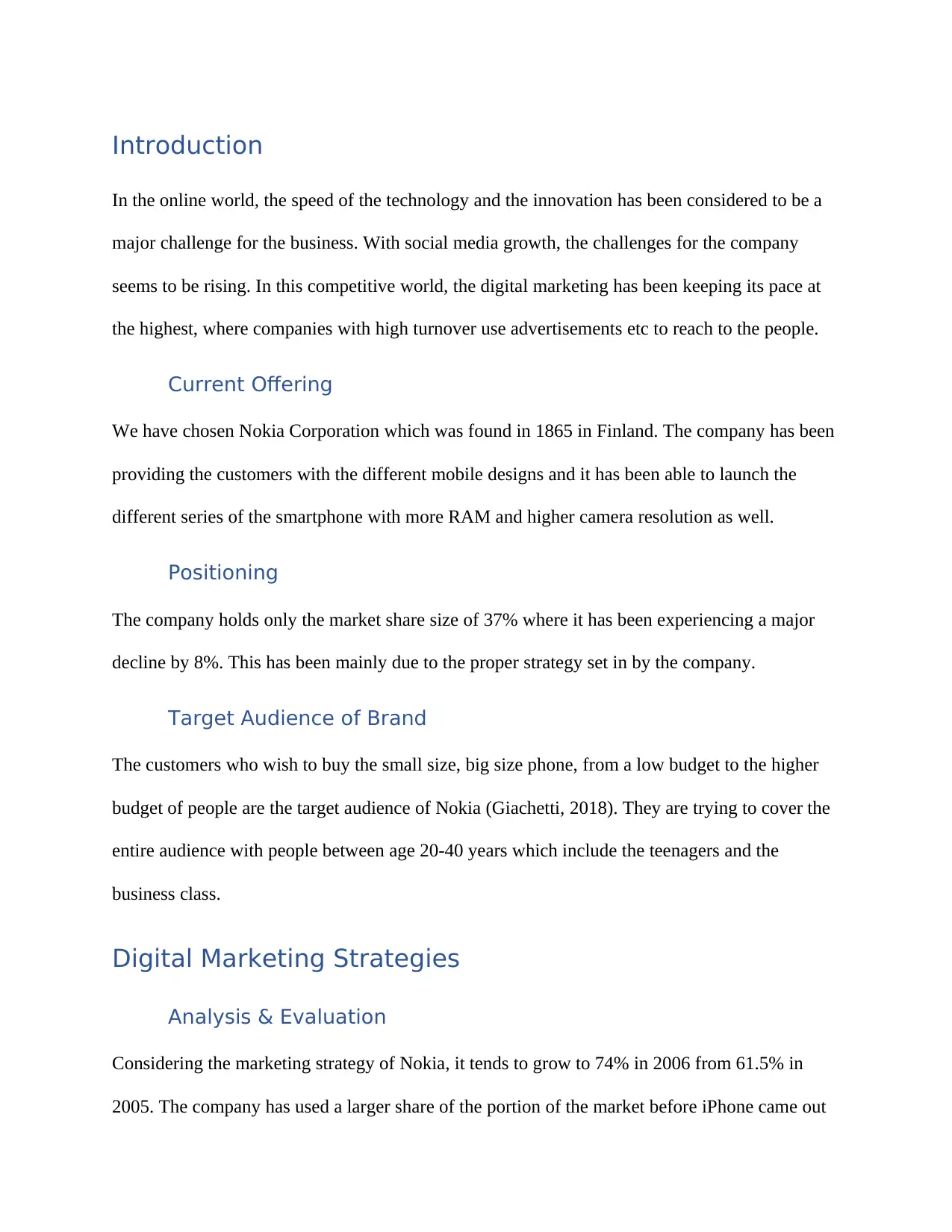
Introduction
In the online world, the speed of the technology and the innovation has been considered to be a
major challenge for the business. With social media growth, the challenges for the company
seems to be rising. In this competitive world, the digital marketing has been keeping its pace at
the highest, where companies with high turnover use advertisements etc to reach to the people.
Current Offering
We have chosen Nokia Corporation which was found in 1865 in Finland. The company has been
providing the customers with the different mobile designs and it has been able to launch the
different series of the smartphone with more RAM and higher camera resolution as well.
Positioning
The company holds only the market share size of 37% where it has been experiencing a major
decline by 8%. This has been mainly due to the proper strategy set in by the company.
Target Audience of Brand
The customers who wish to buy the small size, big size phone, from a low budget to the higher
budget of people are the target audience of Nokia (Giachetti, 2018). They are trying to cover the
entire audience with people between age 20-40 years which include the teenagers and the
business class.
Digital Marketing Strategies
Analysis & Evaluation
Considering the marketing strategy of Nokia, it tends to grow to 74% in 2006 from 61.5% in
2005. The company has used a larger share of the portion of the market before iPhone came out
In the online world, the speed of the technology and the innovation has been considered to be a
major challenge for the business. With social media growth, the challenges for the company
seems to be rising. In this competitive world, the digital marketing has been keeping its pace at
the highest, where companies with high turnover use advertisements etc to reach to the people.
Current Offering
We have chosen Nokia Corporation which was found in 1865 in Finland. The company has been
providing the customers with the different mobile designs and it has been able to launch the
different series of the smartphone with more RAM and higher camera resolution as well.
Positioning
The company holds only the market share size of 37% where it has been experiencing a major
decline by 8%. This has been mainly due to the proper strategy set in by the company.
Target Audience of Brand
The customers who wish to buy the small size, big size phone, from a low budget to the higher
budget of people are the target audience of Nokia (Giachetti, 2018). They are trying to cover the
entire audience with people between age 20-40 years which include the teenagers and the
business class.
Digital Marketing Strategies
Analysis & Evaluation
Considering the marketing strategy of Nokia, it tends to grow to 74% in 2006 from 61.5% in
2005. The company has used a larger share of the portion of the market before iPhone came out
⊘ This is a preview!⊘
Do you want full access?
Subscribe today to unlock all pages.

Trusted by 1+ million students worldwide
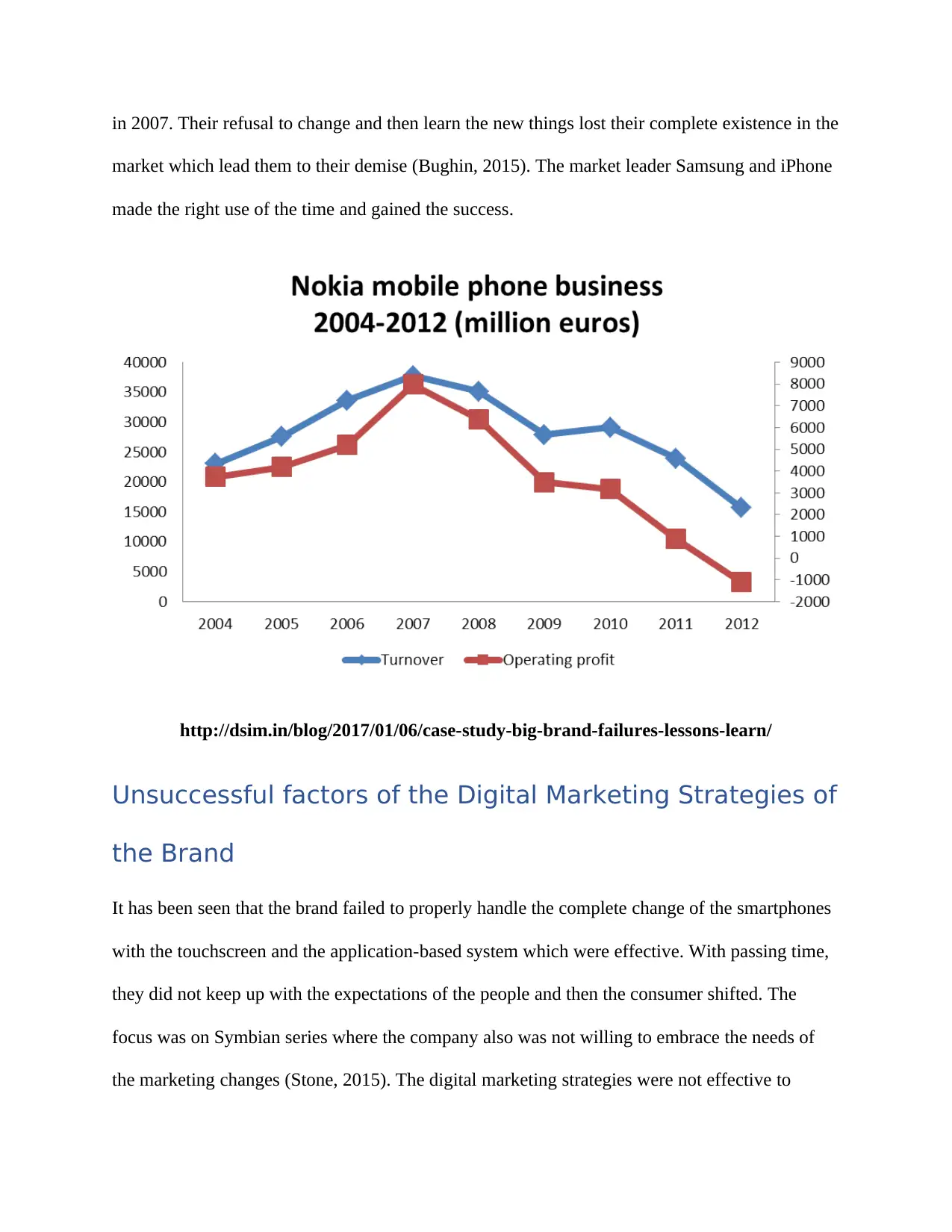
in 2007. Their refusal to change and then learn the new things lost their complete existence in the
market which lead them to their demise (Bughin, 2015). The market leader Samsung and iPhone
made the right use of the time and gained the success.
http://dsim.in/blog/2017/01/06/case-study-big-brand-failures-lessons-learn/
Unsuccessful factors of the Digital Marketing Strategies of
the Brand
It has been seen that the brand failed to properly handle the complete change of the smartphones
with the touchscreen and the application-based system which were effective. With passing time,
they did not keep up with the expectations of the people and then the consumer shifted. The
focus was on Symbian series where the company also was not willing to embrace the needs of
the marketing changes (Stone, 2015). The digital marketing strategies were not effective to
market which lead them to their demise (Bughin, 2015). The market leader Samsung and iPhone
made the right use of the time and gained the success.
http://dsim.in/blog/2017/01/06/case-study-big-brand-failures-lessons-learn/
Unsuccessful factors of the Digital Marketing Strategies of
the Brand
It has been seen that the brand failed to properly handle the complete change of the smartphones
with the touchscreen and the application-based system which were effective. With passing time,
they did not keep up with the expectations of the people and then the consumer shifted. The
focus was on Symbian series where the company also was not willing to embrace the needs of
the marketing changes (Stone, 2015). The digital marketing strategies were not effective to
Paraphrase This Document
Need a fresh take? Get an instant paraphrase of this document with our AI Paraphraser
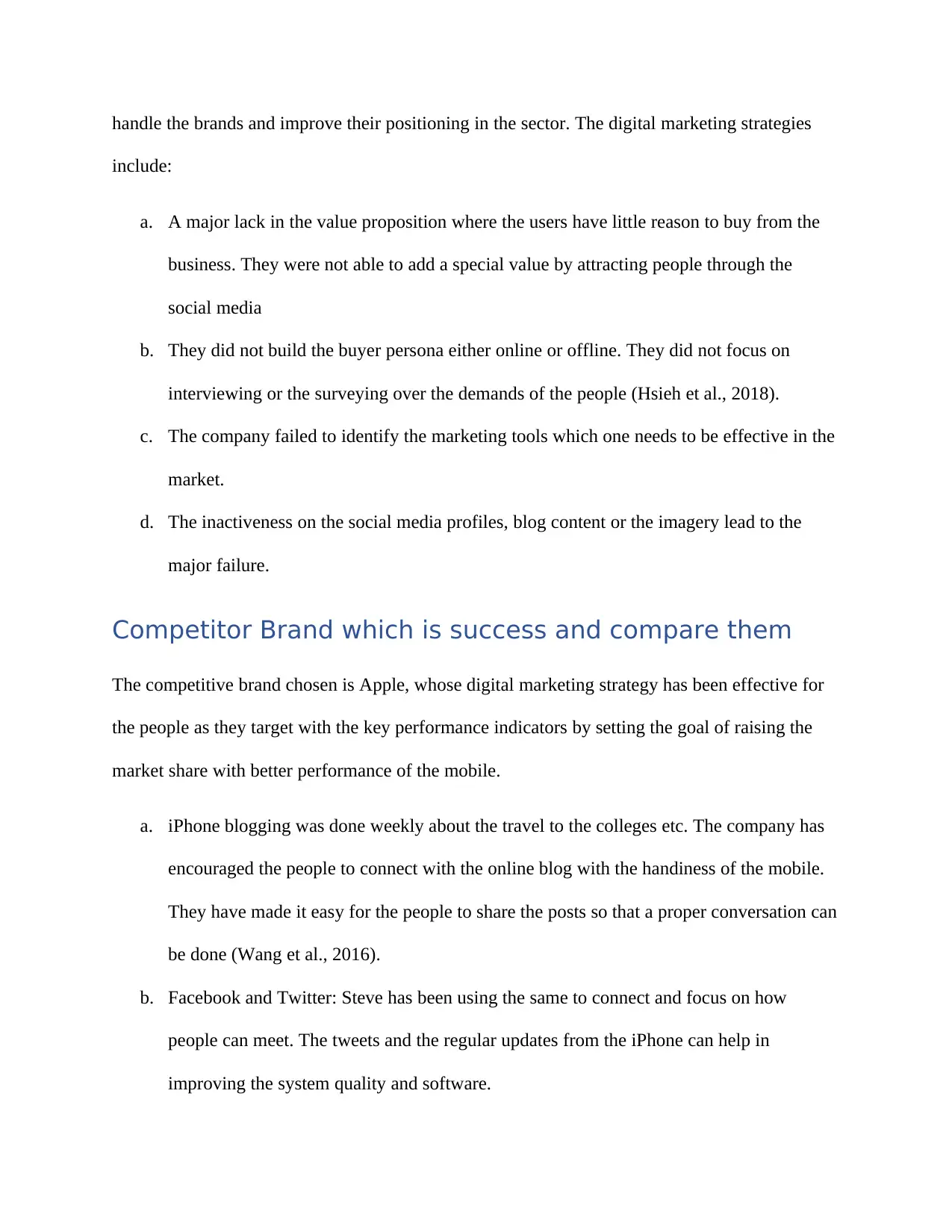
handle the brands and improve their positioning in the sector. The digital marketing strategies
include:
a. A major lack in the value proposition where the users have little reason to buy from the
business. They were not able to add a special value by attracting people through the
social media
b. They did not build the buyer persona either online or offline. They did not focus on
interviewing or the surveying over the demands of the people (Hsieh et al., 2018).
c. The company failed to identify the marketing tools which one needs to be effective in the
market.
d. The inactiveness on the social media profiles, blog content or the imagery lead to the
major failure.
Competitor Brand which is success and compare them
The competitive brand chosen is Apple, whose digital marketing strategy has been effective for
the people as they target with the key performance indicators by setting the goal of raising the
market share with better performance of the mobile.
a. iPhone blogging was done weekly about the travel to the colleges etc. The company has
encouraged the people to connect with the online blog with the handiness of the mobile.
They have made it easy for the people to share the posts so that a proper conversation can
be done (Wang et al., 2016).
b. Facebook and Twitter: Steve has been using the same to connect and focus on how
people can meet. The tweets and the regular updates from the iPhone can help in
improving the system quality and software.
include:
a. A major lack in the value proposition where the users have little reason to buy from the
business. They were not able to add a special value by attracting people through the
social media
b. They did not build the buyer persona either online or offline. They did not focus on
interviewing or the surveying over the demands of the people (Hsieh et al., 2018).
c. The company failed to identify the marketing tools which one needs to be effective in the
market.
d. The inactiveness on the social media profiles, blog content or the imagery lead to the
major failure.
Competitor Brand which is success and compare them
The competitive brand chosen is Apple, whose digital marketing strategy has been effective for
the people as they target with the key performance indicators by setting the goal of raising the
market share with better performance of the mobile.
a. iPhone blogging was done weekly about the travel to the colleges etc. The company has
encouraged the people to connect with the online blog with the handiness of the mobile.
They have made it easy for the people to share the posts so that a proper conversation can
be done (Wang et al., 2016).
b. Facebook and Twitter: Steve has been using the same to connect and focus on how
people can meet. The tweets and the regular updates from the iPhone can help in
improving the system quality and software.
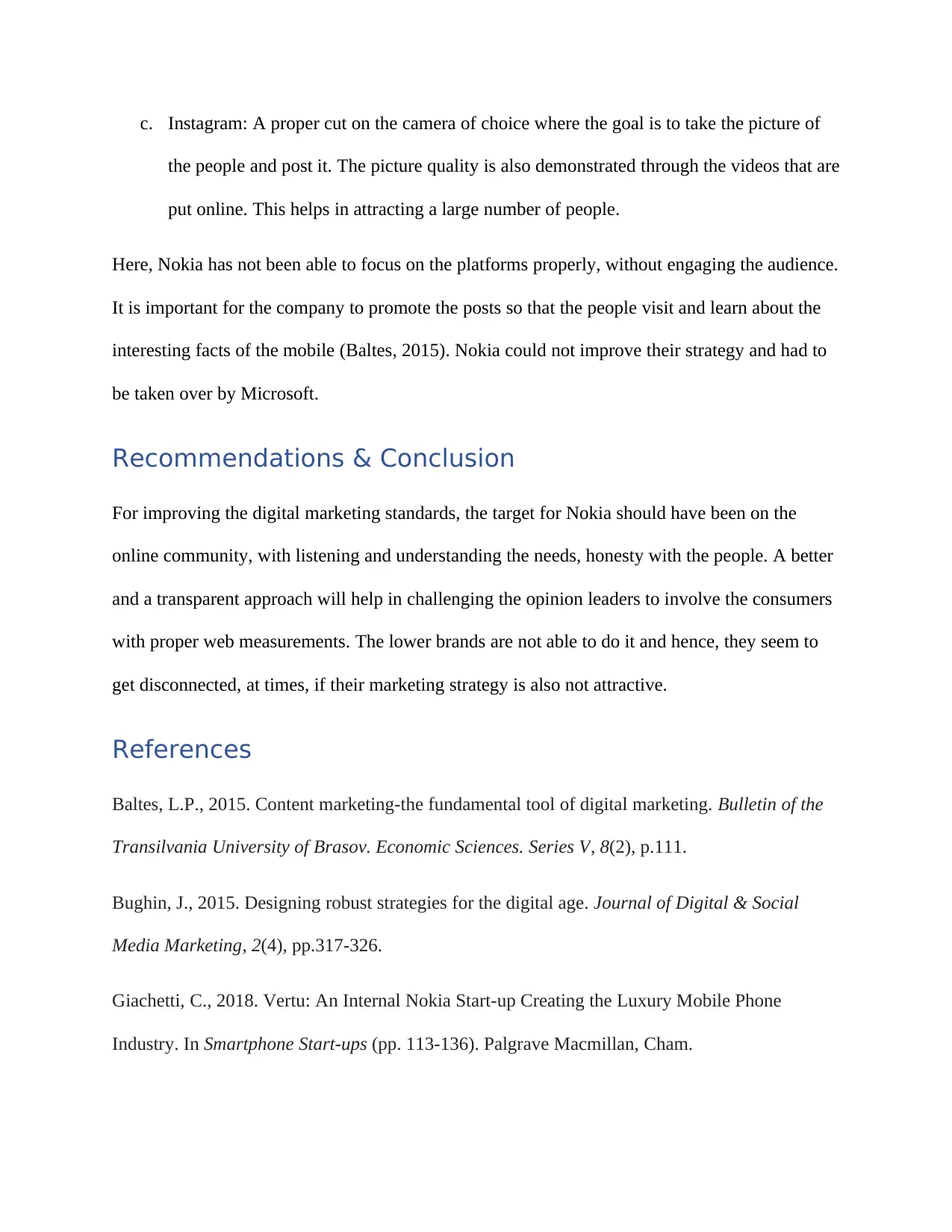
c. Instagram: A proper cut on the camera of choice where the goal is to take the picture of
the people and post it. The picture quality is also demonstrated through the videos that are
put online. This helps in attracting a large number of people.
Here, Nokia has not been able to focus on the platforms properly, without engaging the audience.
It is important for the company to promote the posts so that the people visit and learn about the
interesting facts of the mobile (Baltes, 2015). Nokia could not improve their strategy and had to
be taken over by Microsoft.
Recommendations & Conclusion
For improving the digital marketing standards, the target for Nokia should have been on the
online community, with listening and understanding the needs, honesty with the people. A better
and a transparent approach will help in challenging the opinion leaders to involve the consumers
with proper web measurements. The lower brands are not able to do it and hence, they seem to
get disconnected, at times, if their marketing strategy is also not attractive.
References
Baltes, L.P., 2015. Content marketing-the fundamental tool of digital marketing. Bulletin of the
Transilvania University of Brasov. Economic Sciences. Series V, 8(2), p.111.
Bughin, J., 2015. Designing robust strategies for the digital age. Journal of Digital & Social
Media Marketing, 2(4), pp.317-326.
Giachetti, C., 2018. Vertu: An Internal Nokia Start-up Creating the Luxury Mobile Phone
Industry. In Smartphone Start-ups (pp. 113-136). Palgrave Macmillan, Cham.
the people and post it. The picture quality is also demonstrated through the videos that are
put online. This helps in attracting a large number of people.
Here, Nokia has not been able to focus on the platforms properly, without engaging the audience.
It is important for the company to promote the posts so that the people visit and learn about the
interesting facts of the mobile (Baltes, 2015). Nokia could not improve their strategy and had to
be taken over by Microsoft.
Recommendations & Conclusion
For improving the digital marketing standards, the target for Nokia should have been on the
online community, with listening and understanding the needs, honesty with the people. A better
and a transparent approach will help in challenging the opinion leaders to involve the consumers
with proper web measurements. The lower brands are not able to do it and hence, they seem to
get disconnected, at times, if their marketing strategy is also not attractive.
References
Baltes, L.P., 2015. Content marketing-the fundamental tool of digital marketing. Bulletin of the
Transilvania University of Brasov. Economic Sciences. Series V, 8(2), p.111.
Bughin, J., 2015. Designing robust strategies for the digital age. Journal of Digital & Social
Media Marketing, 2(4), pp.317-326.
Giachetti, C., 2018. Vertu: An Internal Nokia Start-up Creating the Luxury Mobile Phone
Industry. In Smartphone Start-ups (pp. 113-136). Palgrave Macmillan, Cham.
⊘ This is a preview!⊘
Do you want full access?
Subscribe today to unlock all pages.

Trusted by 1+ million students worldwide
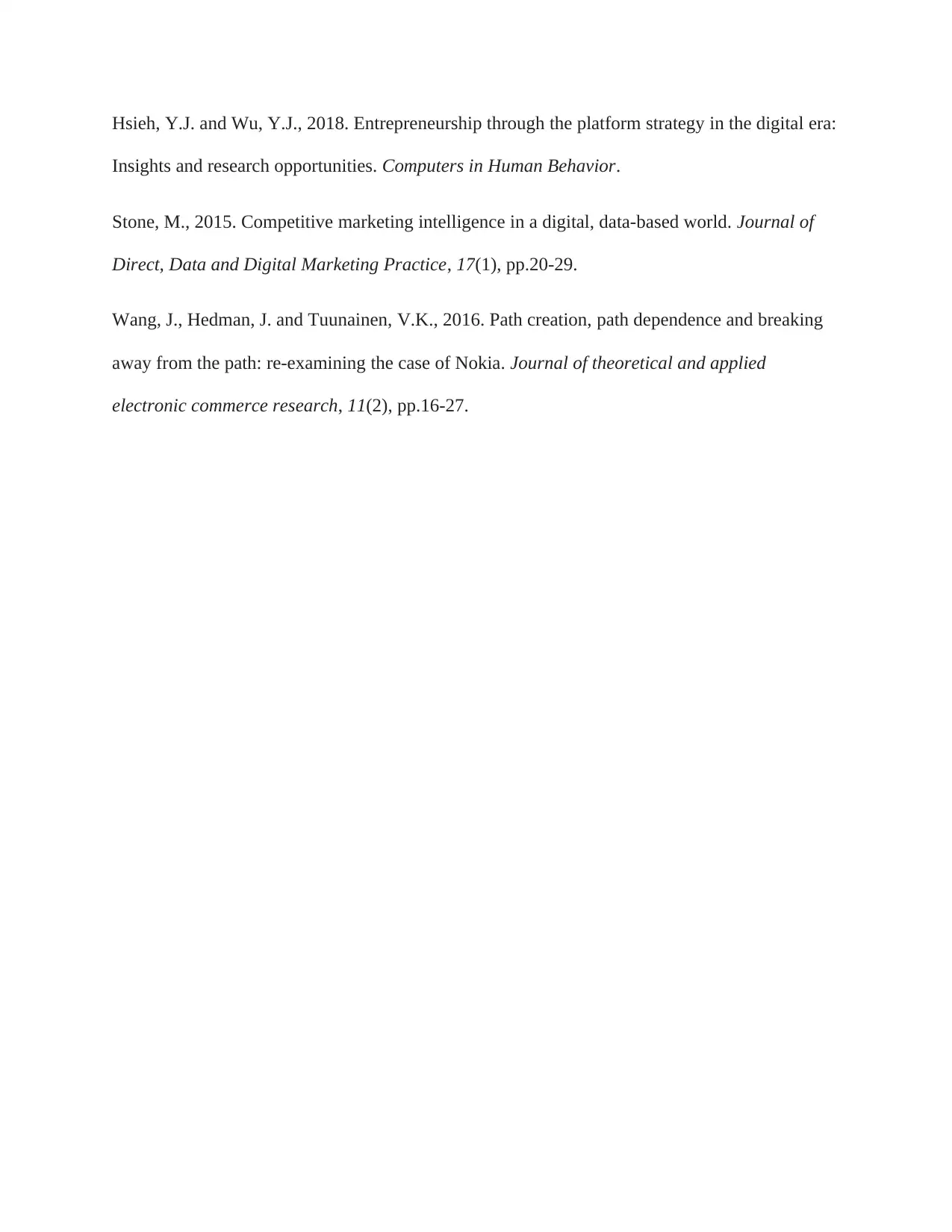
Hsieh, Y.J. and Wu, Y.J., 2018. Entrepreneurship through the platform strategy in the digital era:
Insights and research opportunities. Computers in Human Behavior.
Stone, M., 2015. Competitive marketing intelligence in a digital, data-based world. Journal of
Direct, Data and Digital Marketing Practice, 17(1), pp.20-29.
Wang, J., Hedman, J. and Tuunainen, V.K., 2016. Path creation, path dependence and breaking
away from the path: re-examining the case of Nokia. Journal of theoretical and applied
electronic commerce research, 11(2), pp.16-27.
Insights and research opportunities. Computers in Human Behavior.
Stone, M., 2015. Competitive marketing intelligence in a digital, data-based world. Journal of
Direct, Data and Digital Marketing Practice, 17(1), pp.20-29.
Wang, J., Hedman, J. and Tuunainen, V.K., 2016. Path creation, path dependence and breaking
away from the path: re-examining the case of Nokia. Journal of theoretical and applied
electronic commerce research, 11(2), pp.16-27.
1 out of 7
Related Documents
Your All-in-One AI-Powered Toolkit for Academic Success.
+13062052269
info@desklib.com
Available 24*7 on WhatsApp / Email
![[object Object]](/_next/static/media/star-bottom.7253800d.svg)
Unlock your academic potential
Copyright © 2020–2025 A2Z Services. All Rights Reserved. Developed and managed by ZUCOL.



